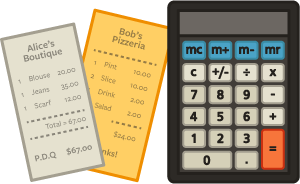
When it comes to making a move to a new city, three main categories of expenses exist: the cost of the move itself, the cost of a new mortgage or lease, and the cost of living in a new community with different prices than you’re used to on the stuff of day-to-day life. Thanks to Moveline, the first part is easy to figure out: our app can help you manage the costs of packing, loading and transporting your possessions.
The second part is a little trickier, but still fairly easy to research, and as for the third, we’ve got a list of secret (until now, anyway) resources to help you figure out what your wallet’s really going to look like on the other side of a move.
Real estate calculators
Researching the price of real estate in your new destination is easy enough online. If you’re moving within the U.S., take a look at Trulia, Zillow, Hotpads and Streeteasy (for New York, Florida, and the D.C. area).
Craigslist is always a useful source as well (just beware of scams).
If you’re moving abroad, check out the cost of living index on Expatistan, where they’ve listed rent prices, home purchase costs, and other living expenses for 800 cities around the world. According to the site’s formula, the most expensive city to live is Oslo, Norway; for reference, New York City comes in 8th. Then again, a dollar today isn’t always the same dollar tomorrow.
To check out predictions for the real estate market in your new city, take a look at CNN Money’s home price data with forecasts for 384 markets around the country.
Cost of living calculators
Although real estate will likely be your biggest expense, to understand what you should budget for life in your new home you need to know how much the basics of daily life will cost you — like public transportation, a typical lunch or night out, a pizza delivery, a movie, and a doctor’s visit.
For a report on the cost of living compiled by the Council for Community and Economic Research, go to coli.org. For $7.95 you’ll get a detailed comparison of the city you’re moving to with the one you live in now. How detailed? They include things like the cost of parmesan cheese, a night of bowling and a trip to the vet.
Bestplaces and CNN Money have calculators that give you an idea of how the cost of living in your present home compares to your soon-to-be home using the costs of food, housing, utilities, transportation and health care.
Nerdwallet, a San Francisco based site committed to giving “consumer-friendly, jargon- free information” about finances, has a cost of living calculator that includes the biggies — housing and transportation costs — as well as the soft costs: a 12-inch pizza, a six-pack of beer, a loaf of bread, a movie and more. According to Nerdwallet, a move from San Francisco to New York — the city they say is the most expensive in the U.S. — will mean a 36 percent rise in cost of living.
And don’t forget the IRS. For an idea of what taxes will be like in your new home, check out taxfoundation.org’s state-by-state listing of taxes, from income, corporate to sales and property.
Budgeting the trip to your new home
No matter how meticulously you plan, you can’t predict exactly how long you’ll be en route; if there’s a delay getting your stuff moved, for example, you may have to add a few days on to your trip. Erik Christensen, a Moveline Move Captain cautions, “be both mentally and financially prepared for Plan B: a longer stay in a hotel, an extended car rental, more restaurant meals.”
Kristina Kurdya, who moved from New Jersey to Virginia to California and made the trip by car, says, “Gas was the most surprising cost of all. You know it’s expensive but you don’t seem to realize it until you notice the stack of gas receipts piling up. With each of my moves, this was the shock factor. Everything else seemed insignificant.”
You can avoid that kind of shock, quite simply, by checking with AAA. Go to its fuel cost calculator online to enter your starting and ending point; then, you’ll be better able to predict how many miles you’ll drive, how many gallons of gas you’ll need and how much it will cost overall. (For example, we calculated a hypothetical trip from San Francisco to New York City in a 2012 Acura. What came up: we’d be driving 2873 miles, using 178 gallons of gas and spending just under $700.)
All in all, a bit of pre-planning can ultimately save you lots of money, whether it’s by opening your eyes to the cost of living in a new town and helping you negotiate the difference into a salary at a new job, or even by showing you more affordable alternatives in other cities. And if you need help planning your move once you’ve settled on the destination, let Moveline help. We demystify the inventory process, get you fair moving quotes from reputable companies, and oversee your move from start to finish. The best part: our services don’t cost you a dime. So, don’t go it alone. Let us help.

Storage units are often an unavoidable fact of life at some point during a move. Whether you’re downsizing to a small downtown apartment from your house in the ‘burbs or simply don’t want to bring all your stuff as your new employer on the opposite coast puts you up in temporary housing while you get acclimated to your new city, chances are, there’ll be a self-storage unit involved. Here at Moveline, we’ve grown accustomed to factoring them into many of our customers’ moves to keep things manageable.
Whatever the case, there are several key factors to consider when renting a storage unit, and who better than John Egan, editor-in-chief of SpareFoot (a great storage finder and facility comparison tool) to explain what to look for?
Check out John’s top 3 things to consider in selecting a self-storage unit:
1. Size
Before signing on the dotted line and plunking down your rental fees, figure out how little or how much self-storage space you need. If you’re storing items that can comfortably fit into a 5×5 unit, you shouldn’t fork over extra money for a 5×10 unit. On the flip side, you shouldn’t cram so much stuff into a unit that it’s practically overflowing.
2. Location
Think about it: Do you really want to store your belongings 10 miles from where you live? While a self-storage facility 10 miles away might be a great bargain, consider the extra time you’d spend traveling to and from your storage unit. Websites like SpareFoot.com and SelfStorage.com can help you find a self-storage unit close to home.
3. Insurance
Check with your homeowner’s or renter’s insurance company to see whether your belongings will be covered while they’re being stored. If they wouldn’t be covered or if you don’t already have insurance, look into buying a policy from the self-storage facility where you’re storing your possessions.
All in all, storage units can be an efficient, effective way to maintain your belongings safely and securely during a state of transition like a long-distance (or otherwise substantial) move. As with most aspects of relocation, choosing the space wisely and carefully weighing your options can potentially save you money and stress in the long run.
And one more note about insurance: check out our recent post on whether or not to get self-storage insurance depending on your circumstances. Hint: chances are, you might already be covered under your homeowner, renter, or business policy.)
If you’re planning a move — storage unit or no storage unit — let Moveline help you navigate the process of figuring out your inventory and getting the best deal from a reputable moving company. The best part: it’s free. So don’t go it alone. Let Moveline help you #movebetter.
(Many thanks to the fine folks of SpareFoot for helping with this post.)

Sure, with big plans up in the air and many small details to manage, moving can be stressful. But with a little preparation and a few quick tricks, it doesn’t have to be so bad.
Wondering how to make moving day as painless as possible? Read on. The experts here at Moveline have some stress-busting tips to make the process simple, seamless and ultimately successful.
Have essentials on hand
Remember that even a simple move several streets away may still take a matter of hours. So, make sure you’ve got the basics available: toilet paper, paper towels, soap and the like. For a full listing of what to keep with you on moving day, read our post about what to keep on hand during a move.
For both yourself and the movers, be sure to keep drinking water and disposable cups out on a countertop to keep everyone hydrated, particularly if your move takes place in the summer or in a situation where a large amount of furniture and belongings are being moved (or a lot of stairs are being climbed). This simple gesture is always appreciated by moving professionals, but sometimes overlooked by even the most well-intentioned of people. Most movers won’t proactively ask for water, so a verbal offer can actually go a very long way.
Keep it simple
Maybe there are certain items you want to keep with you in your own car, or that you’re leaving for the neighbors to take, or that there’s some other grand plan for that doesn’t involve a moving truck (see our recent post on moving in the summer for a special list of things that belong in this category). Be sure to place those items together in the same space before the movers arrive, and openly communicate with them about the fact that they won’t be going onto the truck. The master bath and closet are common safe zones for such things; be sure to mention clearly to every mover on the team what’s going and what’s not.
One common blunder on moving day is forgetting to unplug electronics, from televisions to toasters, before the movers arrive, which can cause unintended delays and small calamities. A bonus tip: remove all light bulbs from lamps to prevent them from breaking in transit, unless you’d really prefer to buy all new bulbs for the new place. Stripping the bed is also expected. Leaving the sheets, comforters and pillows in the center of the bed is fine if the movers are packing them; if not, surely there’s a box for that. In any event, keep the mattress and box springs bare so the movers can get to them easily.
Clear a path
Ideally, small children and pets are off the premises of both the old and new homes during the move itself, being taken care of by a trusted third party. In cases where it’s physically impossible to have them apart from you for a few hours on the day of the move, make sure they’re in your sights at all times, and out of the way of the movers. Dogs and cats tend to run away in times of transition when untethered, and small living things of all species can easily place themselves in harm’s way without seeing that bookshelf careening around a blind corner. So truly — for everyone’s safety — make arrangements in advance. Also, check out our post full of advice on moving with a pet.
Making it easy for the movers to get from point A to point B in both your old and new places can cut down on your move time considerably. In private homes, make sure the sidewalk and at least part of the driveway are clear for dollies to move swiftly between the truck and the residence, and in shared spaces like apartment buildings, it’s wise to reserve an elevator in advance if possible, and secure any loading zones or side entrances that may be helpful for getting your belongings in and out without a hassle.
Make yourself available
It’s amazing how many surprises can lurk unseen and ruin your day if you don’t plan ahead, so be prepared for the final walkthrough well before it happens.
“Start thinking ahead of time about those sneaky spaces, like cabinets, where you forget you have stuff hiding,” urges Erik Christensen, a Moveline Move Captain. Once the move is complete, it’s complete, and as for those random tchotchkes buried in the back of the closet and canned goods lined up in the bottom kitchen drawer, you’re basically on your own to deal with them. So, have an empty box or two and a magic marker on hand and be present during the final walkthrough. A couple of boxes full of random stuff is nothing to a mover with a dolly; it’s something else altogether when it’s just you, your own two arms and several flights of stairs after the truck is gone.
Most importantly: if you have to leave the premises while your move is in progress, whatever you do, don’t return later than expected to sign the final paperwork. In most cases, movers have multiple stops to make in a day, and your actions — however innocent — can throw off someone else’s move completely.
Tip the movers
Last but not least, tipping is standard. It’s customary to tip each mover $20 for expected services, or up to $100 apiece for a truly stellar job maneuvering awkward walkways, flights of stairs, delicate objects and any other special considerations that may have arisen during the day. In instances where there’s a fleet of movers (i.e., more than three) and handing out individual bills would seem awkward, it’s best to give the total amount to the lead mover and ask him or her to divide it evenly among the team. And if you had a truly superior experience with your moving company and want to spread the word about them, there’s always Yelp. (By the way — shameless plug alert! — if you used Moveline to oversee your move and want to help others save money and stress in much the same way, kind reviews are always welcome onMoveline’s Yelp page as well.)
If you’re planning a move but haven’t hired a mover yet, let Moveline help. We simplify the entire process by helping you inventory your belongings and gathering quotes on your behalf from reputable movers. We even assign you a Move Captain to oversee everything from start to finish, and our services are free. If that doesn’t make moving day less stressful, nothing will! So don’t go it alone. Let us help you #movebetter.

The last thing anyone wants to do after dealing with the stress and expense of a move is spend more money. The good news is, if you’re new in town — or even if you’ve simply moved across town — you might have more bargaining power than you realize when it comes to saving some cash.
Remember the advice Alicia Silverstone’s iconic character, Cher, gave to the new girl in school (played by Brittany Murphy) in Clueless? “Don’t sell yourself short. You’ve got something going for you… that no one else has. Mystery. If you strike while the iron is hot, you can have any guy you want.” Granted, in this case, we’re talking about money instead of potential love interests, but the principle is the same. New customers are the lifeblood of most service providers, so when you approach one with a potential piece of new business, the power is in your hands — not theirs.
Cable and Internet
Starting close to home, ask the new landlord (or neighbors, or the internet) what cable and internet providers service your new building or ZIP code. Those insanely low-priced cable-and-internet deals your own current provider is advertising on television? Just try calling them up and asking them to reduce your current rate at the address where you’re already receiving their services. No dice. “That special is only for new customers,” they’ll say. Indeed, new customers are the highest priority those companies hold. So when you move, use it to your advantage and become one of them, whether it means switching companies or — if your provider is also available at the new place — simply cancelling your old account and starting fresh with a new one instead of asking for a transfer.
Gyms and Fitness Clubs
Do your homework when it comes to deciding where you’ll be sweating out your stress and extra calories once you’ve moved. Some gyms — particularly the large national chains — offer better deals online than they do when you’re speaking in person with a membership rep, whose job, quite frankly, is basically to get you to spend as much money on a new membership as possible. Don’t be surprised if they gloss over the numbers and take you to the cleaners in the process. On the other hand, if your powers of negotiation are strong and/or you’re looking at a locally-owned gym with fewer corporate rules and more flexibility, you might be able to strike a deal of your choosing and save some dough on your daily fitness routine.
Furniture and Home Goods Stores
You don’t need to apply any special strategy at all when it comes to saving money on decorating your new space. When you fill out your post office change of address form, you’re also signing up for more than $500 in savings at participating retailers, many of which are home improvement, furniture and decor stores we all know and love. A packet of coupons typically arrives at your new home within a week of your move date. You can also sign up for several free store catalogs, many of which have additional coupons inside.
Other Neighborhood Spots
On occasion, all it takes to catch a break is a smile and a little bit of kindness. Striking up friendly conversations with your new barista, sandwich artist, or whomever else you’ll be seeing on a near-daily basis can yield you a treat or two on the house when you mention you’re the new kid on the block. And even if they don’t, well hey… at least you’re spreading goodwill around your new neighborhood, and no matter what, even though it’s great to get a freebie every once in a while, it’s always nice to be nice.
If you’re planning a move, let Moveline help. We’ll save you money by simplifying the inventory process and getting fair, accurate quotes on your behalf from reputable moving companies. Then, we’ll oversee your move from start to finish — for free. Don’t go it alone. Let us lend a hand. Visit our homepage to get started.

When you’re moving, it doesn’t matter if your new home is 5 miles away or 500 — lots of variables are very much in play. Once you’ve signed a lease or closed on a home, you’ve undoubtedly taken into account its distance from your job, what school district it’s in, and other major factors that will heavily impact your life. But before you actually turn the key on your first day in a new home and start getting acclimated, consider the Moveline team’s recommendations for places to bookmark in your new neighborhood. Doing your homework now can save you time and irritation later; a few minutes’ worth of Googling in advance of the big day can definitely make life a little easier amid all those boxes.
Grocery Store & Pharmacy
If you’re lucky, there’s a grocer with a built-in pharmacy right around the corner from your new home, and you’ve already walked or driven past it. If not, though, it’s wise to know offhand exactly where to go if you need to make an emergency run for toilet paper, toothpaste, ibuprofen or — of course — bacon.
24-Hour Clinic
Speaking of emergencies: unpacking, rearranging furniture and generally being in a new environment can create a minefield of little disasters just waiting to happen. It’s certainly no fun dealing with an unfortunate box cutter incident, but it’s a hundred times less awful if you already where to get it taken care of, even at 3 in the morning.
Pizza Delivery
Barring all moving-related injuries, the process of unpacking can actually be sort of an adventure if you let it, but all adventures require fuel. It hardly feels like a first night in a new place without pizza, Chinese food or some other delicious delivery from your new neighborhood’s most reliable dial-up dinner joint. When you place your first order, let them know it’s your first night in the area. You just might get your first meal on the house. (The same goes for your first takeout cup of joe the following morning at your new coffee place.)
Gym
You’ll probably want to start working off those first few greasy meals as soon as possible, so there’s no better time than before your move to look up the nearest gyms and start making your decision early. For the fitness procrastinators among us, moving to a new home is the perfect time to begin healthy new habits, so it’s smart to strike while the iron’s hot, and for those who can’t go a day without their cardio — well, you’ve probably already signed up for a trial membership anyway.
Dry Cleaner or Laundromat
During a move, it’s amazing how laundry seems to pile up at a rate startlingly more rapid than usual. In order to keep from looking like a total schlub, have your local dry cleaner and/or laundromat (if you need one) already on your radar screen before you arrive. Your family members and co-workers will thank you.
If you haven’t yet finalized your move, let Moveline help. We demystify the inventory process and gather quotes from reputable moving companies on your behalf, giving you a fair and accurate deal with people you can trust. Don’t go it alone. Let us help — for free.

It kind of defies logic; although summer is the least convenient time of year for a move, a majority of consumers inexplicably choose those sweaty and sweltering months to relocate anyway.
So, the Moveline team has put together a helpful list of ways to minimize the stress and potential damage you could accrue by changing addresses during the hottest season of the year. And luckily, if you just can’t heed #1 — the smartest advice we can give — never fear; we’ve got nine more tips for backup.
1. Don’t move in the summer.
If it’s at all possible, don’t schedule a move for the summer. From May 1 to Labor Day (the moving industry’s definition of summer), things go crazy. That’s when parents with school-age kids move, and that’s when the military does their personnel moves.
“When I drove a moving truck, over 60 percent of our moves were military and were in the summertime, the same time that a lot of civilians want to make a move.” says Erik Christensen, a Moveline Move Captain. According to US Census data, almost 50 percent of all moves take place from June to September. If you include May, it jumps to 65 percent.
Moving in the summer is like trying to fly over Thanksgiving; because it’s the busiest time of year, the prices are higher, schedules are squeezed, and the industry just doesn’t have enough driver capacity to meet the consumer demand for moving services. This causes blackout dates, long delivery spreads, and overall, fewer choices for you as a customer. With a summer move, you may not get the best packers and drivers — companies have to hire on extra help in the busiest months, so you may not get the most experienced professionals. For a fall, winter or spring move, on the other hand, you may be able to negotiate a 10 to 15 percent price reduction with the moving company while enjoying the benefits of more seasoned service.
2. If a summer move is unavoidable, start planning as far ahead as possible.
Moving in July? Start your research early and begin planning in May. At the very least, book six weeks ahead of time. As Christensen explains, “When I was booking moves for a long distance moving company last summer, people would call me five weeks ahead to book a summer move, and my hands were tied — there was no way I could fit them in.“
3. Arrange to move on the least busy days of the week.
Try to move on a weekday in the middle of the month. Whatever you do, avoid Memorial Day weekend and the last weekend in July — they’re the 1st and 2nd busiest moving days of the year.
4. Be realistic about packing.
Do you really think you can pack yourself? If you’re certain, fine. Just remember that if, right before a summer move, you decide you can’t and need help from the moving company, they may not be able to provide it. No matter how much you’re willing to pay, the moving company you hire might not have the crew to spare. Most people want to save money by packing themselves — they figure they’ll do it slowly, collect boxes, pack a few a day… but often, that doesn’t happen. Work obligations or illness get in the way. Life intervenes.
5. Build in flex time when planning the move.
Even if you’re moving within the same city, allow yourself time for something to delay the move. The possibilities are endless. There can be truck breakdowns, unforeseen personal circumstances can arise, and movers can call in sick on your scheduled day. Above all else, plan to take an extra day off from work.
Most movers offer a guaranteed delivery date compensation plan if they miss the promised date, but the amount you will receive will not be enough to entirely pay for extra nights in a hotel/motel if you’re taking a road trip to your new home. A mini-vacation that you may have planned around your move may not be quite as “mini” as you thought, so pack accordingly. Have a Plan B and be mentally prepared to use it. Don’t lock yourself into a housewarming party for the day or two after your estimated arrival date. Warn the relatives that you may be staying a bit longer than anticipated. Make sure you can extend your car rental.
6. Be aware of what things should not be put into the moving van in the summertime.
Candles in a van driving through the desert in the summer will melt all over your other stuff; carry them with you instead. Leather upholstered furniture will “sweat” if wrapped in plastic; use a pad instead. CD’s, videos and cassette tapes can warp in a hot truck. Plan ahead to keep vulnerable items out of the heat if you want to keep them intact.
7. Be kind to the movers — they’re hot too.
Julie Steed is a military spouse who has relocated her family 10 times in the last 14 years, always during the summer (she blogs about relocation at juliesteed.com). Here’s what she advises: “Have cold water available for the packing crew. Respect their needs to take reasonable breaks, especially if it’s uncomfortably hot. My family always offers to give the crew lunch. If it’s financially feasible for you to do the same, it’s a gesture of goodwill that goes a long way.”
Christensen agrees: “Your moving guys have probably been working 14 days straight through in the summer — they really appreciate, water, lunch and bathroom breaks.”
8. Plan carefully for your kids on moving day.
Your children will need a safe, climate-controlled place to play, nap and stay out of the way of the moving crew. It’s probably best to find someone to babysit for them at both ends of the move.
Steed recommends that you hand carry transcripts, vaccination records and other documents you might need to register your child at a new school. Avoid having to search through packed boxes for documents you’ll need; call ahead to find out exactly what paperwork is required.
And to help the kids meet other kids their age in the new neighborhood before school starts, check out local camps, sports leagues and special kid-friendly events to ease their transition into their new community.
9. Think about air-conditioning at both ends of the move.
Steed reminds anyone moving in summer that “the doors to your home will be open for extended periods of time and the temperature inside will reflect the temperature outside. Prepare accordingly, remembering that you will literally pay the price if your air conditioners run for hours on end.”
And be sure that the electricity is turned on in the new home if it’s going to be hot there too.
10. Plan for your pets.
Make arrangements for your pets, particularly dogs and cats. Work out a way to keep them away from the movers.
“They’ll need unhindered access to your home and yard,” says Steed
“so it’s best to put your pets in a kennel or have a friend take care of them. The yard is not a good choice for animals on a summer moving day because of the heat. It’s also unreasonable to expect the moving crew to keep yard gates closed.”
For more detailed tips on keeping Fluffy and Fido safe, healthy and happy during a move, check out our post on how to move with a pet.

Here on the Moveline blog, we’ve already covered what to ask your future (or potential future)landlord before moving into a new place, but in today’s post we’re focusing on what to clear with your current landlord before you move out. Since an ounce of prevention is almost always worth a pound of cure, these questions are most definitely worth asking; they may save you an abundance of time and money.
What are the exact cleaning requirements and fees?
We’re not suggesting you leave an apartment in shambles by any means, but when it comes to cleaning and repair fees, sometimes it’s worth your time and money to leave things to the professionals. Find out exactly what’s expected of you when you move out, and what the corresponding fees are for services that may need to be rendered once you’re gone.
If the property manager charges a flat fee for professional carpet cleaning and it’s a) cheaper than hiring a company on your own and b) less of a hassle than renting a machine and trying to do it yourself, simply running a vacuum and paying the fee might be the best option.
Likewise, some equations are true no-brainers. If there’s a $75 fee for repainting the walls once you’ve left, but repainting them yourself will cost more than that in paint supplies alone, the more efficient option is — again — to let the professionals handle it. On the other end of the spectrum, dusting and wiping down every surface and cleaning the bathroom might save you a decent amount of cash, making it completely worth the elbow grease and the $5 you dropped on a bottle of all-purpose cleaner. If leaving the walls full of tiny nail holes carries a hefty fee, a five-minute spin around the old apartment with a $4 tube of Liquid Nails from the local hardware store is probably worth your investment. When push comes to shove, let your inner economist figure out what’s best for you.
What time should you turn in your keys?
Sure, you know your move-out date, but when it comes to kissing the place goodbye and relinquishing the keys, do you have until midnight, or only until the management office closes? It may seem overly simplistic, but making sure you can meet the deadline in the midst of a move may save you a pro-rated day of rent, and from the standpoint of common courtesy, it may give your old landlord more time to prep the apartment for new tenants in the event of a quick turnaround.
Ideally, you may even want to schedule the move itself a day or two (or even more) in advance of your last day of occupancy to give yourself some wiggle room and reduce your stress overall.
Can you make life a little easier on the day of a move?
It may be possible to reserve and elevator, cordon off a loading zone and otherwise make for an easy getaway with a little advance planning. All you have to do is ask.
How soon can you expect your refunded deposit?
It’s not unreasonable to politely ask when you might anticipate receipt of your refunded deposit — or whatever portion of it will be due once any deductions have been made. Make sure your property management office has your forwarding address on file so there’s no confusion or delay.
Can you have a letter of reference?
Depending on where you move in the future, it may be helpful to have reference letters on hand from the managers of your former places of residence. With high turnover, your former landlords and property managers may no longer be reachable when you need them, so it may be wise to ask for something in writing now — provided, of course, that you’re leaving on good terms.
Regardless of what you’re leaving behind and where you’re planning to land (in the United States, at least), Moveline can simplify your move. We’ll help you find the best deal, take the mystery out of the inventory process, and oversee your move with a professional, reputable moving company from start to finish. Don’t go it alone. Let us help. It’s why we’re here.

Although moving is rarely simple, a bit of intelligent planning (and working with the right tools, like Moveline) can prevent all sorts of headaches in the long run. That’s why we’ve put together a helpful list of things to confirm with a new landlord or property manager before you sign a lease (or mortgage, for that matter) and move into a new place.
Can you have pets?
Few of us with pets would ever be willing to let them go simply because a new apartment won’t allow them. When it comes to pets, the policies run the gamut from animal-loving to quite tough. Some landlords and property managers may allow pets of all kinds (or under a certain weight limit) with just a refundable pet deposit, while others may have breed restrictions and charge not only a deposit that may or may not be refundable, but also a monthly pet fee (sometimes referred to as “pet rent.”) Particularly since the very act of moving with a pet carries with it a lot of extra responsibility, it’s important to know what you’re getting into before you jump headfirst into signing that lease or pursuing that co-op.
Who’s responsible for what services?
Before you can get a clear picture of what your monthly expenses will look like, it’s important to know what you’re responsible for and what you’re not. Are you obligated to pay for electric/gas, water/sewer and garbage collection, or are portions of those utilities taken care of by the management? What about pest control? If there’s a lawn (in the case of a townhouse, duplex or rental home), are you responsible for maintaining it, or is a service provided at no cost to you? Your monthly budget can be affected by hundreds of dollars depending on what’s expected to come out of your pocket versus what’s already taken care of, so be sure to ask specific questions about every possible expense.
Will everything fit?
Look, we love IKEA, but let’s face it: that modular wardrobe system you put together with your own bare hands in your current apartment probably isn’t going to be broken down into perfect modular pieces and put back together again in perfect shape at the new place — that’s just not how particle board works. So, for those larger items of furniture, find out if the hallways, stairwells and/or elevators will accommodate them during the move, or if you’re fighting a losing battle. Likewise, be sure to take proper, wall-by-wall measurements of the entire home; simply knowing the overall square footage and eyeballing the dimensions won’t help you when moving day comes and your headboard is three inches too long for your bedroom.
One more pro tip on layout: make a note of where all the cable and electrical outlets are; that knowledge, coupled with accurate dimensions, will help you plan out what goes where in the new space, helping you sidestep a lot of undue stress while saving the movers a good deal of time.
Can the movers be accommodated?
Speaking of movers, it’s important to know what obstacles they might face on moving day, as well as what resources they’ll have at their disposal. Find out from your potential landlord if there’s a loading dock or zone the movers can use to park the truck and do the unloading; also, ask if the elevator(s) can be reserved, and if so, what the restrictions might be on days and times. Generally speaking, buildings that allow new tenants to reserve elevators for move-in only do so on the weekend and during off-peak weekday hours, but figure out exactly what you’re dealing with before moving day arrives so the process can be as seamless as possible. If you’re moving into a building in a densely populated area, this is a critical step. If the truck can’t park and unload at your new home, the moving crew you hire may have to shuttle your move, which adds time and extra costs to the move, especially if it’s not planned for in advance.
Can you paint?
Particularly if you’re a stickler for decor, find out if you’re allowed to paint the walls (if you sense an opportunity to bend the rules, explain that you’ll paint them back to their original color before you leave — occasionally, that bargaining chip works wonders), as well as whether or not other modifications (wall hangings, full window treatments) are permissible. Even if they’re not, there are plenty of inventive and attractive workarounds, but it’s best to know up front for obvious reasons.
Are there any dealbreakers?
Just as one man’s trash is another man’s treasure, one person’s dream home can be another’s nightmare scenario. Case in point: while the charm of that pre-war apartment may leave quite an impression, the water pressure in the shower might not. The same can be said for the hustle and bustle of living in the city; while some may love the buzz of metropolitan life, the nightly wail of sirens may be too much for others to take. Living near a cemetery means peace and quiet for some, but spooks others away. On a serious note, parents in particular may wish to check the state or national sex offender database to see if any predators reside in the same building or on the same street.
Your needs (and dealbreakers) may be completely unique, but listen to your gut when making a decision about where to live, and then see what can be changed and what can’t. In the end, home sweet home is only as sweet as you perceive it to be. It’s worth taking the time to make sure your next one is one you can truly live in. The only thing more painful than moving, is having to do it twice.

April 15 has long struck fear in the hearts of procrastinators everywhere — in the United States, anyway. Whether you owe or are owed, the process of filing one’s taxes isn’t exactly a walk in the park, but the Moveline team has a bit of good news for you: if you’ve moved in the past tax year due to a new job or job location, there’s a good chance you can deduct those expenses from last year’s federal taxes.
Even better news: the form you’ll need to fill out is likely one of the shortest and most straightforward documents the IRS offers. If you’re filing your 2012 taxes before the April 15, 2013 deadline, you’ll need Form 3903 for 2012 , entitled “Moving Expenses.” It only has five lines to fill out, and in them, you’ll report whether your move was paid for with your own out-of-pocket funds, your employer’s funds, or some combination of both. If you were left holding the bag on any amount of your moving costs after your employer’s limit was reached (or if you were paying for the process on your own to begin with), you can likely deduct that amount from the income you report.
How to deduct taxes related to your move:
-To qualify for a deduction, first and foremost your move must have taken place in the tax year for which you’re providing information to the IRS, and it must have taken place for either a job or a job location (i.e., you either relocated for work or your place of business moved far away, forcing you to move your residence to be closer to it.)
-You cannot deduct money that was actually spent by your employer; it’s not yours to claim. Any deductions you request must be as a result of your own out-of-pocket expenses.
-Per the IRS: “Under the ‘distance test,’ your new workplace must be at least 50 miles farther from your old home than your old job location was from your old home. If you had no previous workplace, your new job location must be at least 50 miles from your old home.”
-There’s also a “time test” which states that, according to the IRS, “If you are an employee, you must work full-time for at least 39 weeks during the first 12 months immediately following your arrival in the general area of your new job location.” Different parameters apply for taxpayers who are self-employed.
-It’s important to review all the exceptions and nuances to these rules; check the Moving Expenses page of IRS.gov for specific details.
This is just a basic primer to help you determine whether or not you might potentially qualify for a moving expenses deduction. When in doubt, always ask the IRS or a reputable tax accountant.
If you’ve moved since January or are planning a move for the upcoming year, be sure to keep all relevant documents accessible for the next tax season. And while you’re at it, letMoveline help you plan all the logistics and save money in the process. That’s why we’re here in the first place.

At Moveline, we’ve seen more than our fair share of moves — after all, it’s what we do. Time and again, we’ve helped couples move in together under all sorts of circumstances. In one particularly noteworthy instance, a long-distance couple, Tim and Alaina, braved Hurricane Sandy with us on their moving day to start their new life together under the same roof. In another, we moved a couple not once, but twice, in one month after they realized their first place together could never work (it was right above a bar). And the stories go on and on as cupid strikes all sorts of victims, making them go silly enough to overlook each other’s weird and wake up together every day.
No matter how diverse people might be, some common themes run strong when two people who love each other decide to make a go of it together. So, we’ve put together a handy, comprehensive guide for those about to plunge into domestic bliss with one another — and we’ve got more than a few tips to share in an effort to keep that bliss from turning blustery.
What we cover in Moveline’s Guide for Couples Moving in Together
Here’s an overview:
- There are plenty of perks to cohabitating with your partner, from the financial to the emotional. While it’s important to set parameters and respect each other’s space, the benefits to living together (when it’s a healthy relationship, anyway) are innumerable.
- Looking before you leap is critical: Are you moving to a new place together or simply giving up one of your apartments to move into the other one? What stuff stays and what stuff goes? We’ve got some great tips for resolving those kinds of questions, and there’s even an infographic to help you decide what to keep and what to toss if you reach an impasse.
- Like snowflakes and fingerprints, no two couples are exactly alike. As such, “The Money Talk” means something different to everybody. The good news: there are a handful of intelligent guidelines that can make a conversation that’s delicate by definition an awful lot more bearable, with the sort of outcomes that even the most hard-headed firecrackers can get on board with.
- Depending on where you move together and how, you might need more documentation than you planned for. Never fear; we’ve got a checklist of things to gather before you start chasing after that lease (or even that rental application).
- So many questions: Should you hire movers or do it yourself? What about a storage unit or pod for all that extra stuff? Answers to all that and more are just one click away… and they’re free.
Our Ultimate Guide for Couples Moving In Together is available online at no cost. Enjoy, and good luck, lovebirds. May the force be with you.
Moveline simplifies the moving process by demystifying the inventory process, gathering quotes on customers’ behalf, and overseeing every aspect of each customer’s move. Don’t go it alone. Let us make it easier. It’s why we’re here — to help you #movebetter.